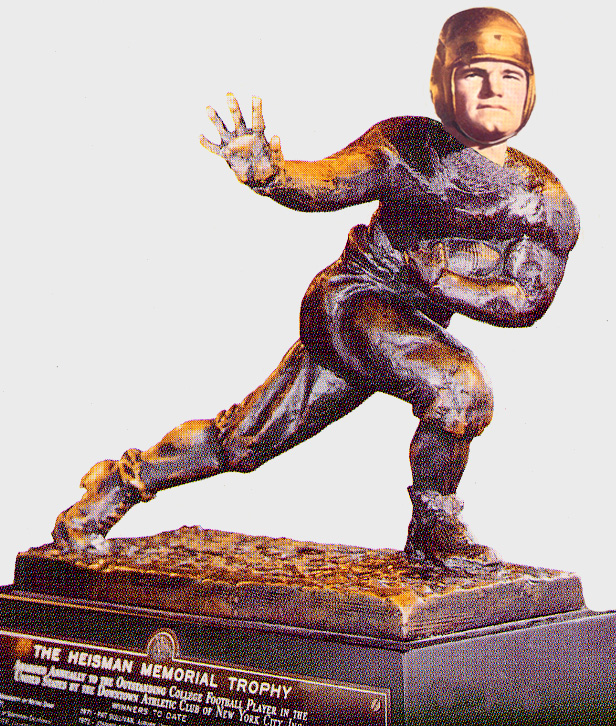|
A
composite by the author places a helmeted Nile Kinnick bust atop the
traditional Heisman trophy which
By
Bob Hibbs
Phi
Beta Kappa law student Nile Kinnick ran, passed and kicked his way to the 1939
Heisman trophy and to University of Iowa football legend status while earning
his way through college working at Iowa City’s First National Bank.
He
was named the Associated Press athlete of the year ahead of Joe DiMaggio, Ben
Hogan and Joe Lewis.
Kinnick
died three years later when his fighter crashed into Caribbean waters on a
training flight off the carrier USS Lexington, a death “mourned as a
national tragedy,” writes John Gerber in his 1988 UI history. The
university’s football stadium was named for Kinnick in 1974.
In
unpublished material left with this reporter, the late Press-Citizen sports
editor Al Grady writes of the Iowa team and coach Eddie Anderson:
“His
spring practices were so demanding that about half of the already small squad
quit, leaving him with 28 players for the 1939 season. What they did, a few of
the front-runners, was play 60 minutes of offense and defense in most of the
games, thus earning the nickname ‘The Ironmen.’ It was not unusual for
seven or eight players to play an entire game without relief.
“Their
7-1-1 record is far from the best in Iowa history, nor should they be listed
as Iowa’s greatest team ever, but because it was assumed they would continue
Iowa’s record of football futility, because they captured the hearts of the
entire nation, they remain today, almost 65 years later, as the most revered
of all Hawkeye football teams.”
Grady
continues: “The two games that really put them in the national spotlight
were back-to-back triumphs in November against then unbeaten Notre Dame and
then national power Minnesota, looking for its fourth national championship in
six years.
“Kinnick,
not surprisingly, was the ringmaster in both games, although certainly not
without a lot of valiant help. As usual, he played the entire game (against
Notre Dame). He changed a play in the huddle, switched from left to right
halfback, and rammed four yards for Iowa’s only touchdown, then drop kicked
the extra point.
“The
next week was more of the same when the much bigger and deeper Golden Gophers
rolled into town and built a 9-0 lead during three quarters, but Kinnick threw
fourth-quarter touchdown passes that rescued a 13-9 victory which a Chicago
reporter tabbed, “the most spectacular football game in modern Big Ten
history.” P.S.
Al Grady died last week leaving a great big hole in the psyches of all who
knew him. He was this reporter’s first boss out of college nearly 40 years
ago when the P-C didn’t have an expected opening in the newsroom, so put us
to work as Al’s assistant.
Rather
than as sports fan, Al’s strongest trait for us was writing; his absolutely
nit-picking insistence on correct language, spelling and punctuation, as well
as sentence formation and the rest. It remains burned into us to this day.
When
it came to language, Al was a perfectionist; a damn good one! He knew when to
use “which” rather than “that;” when to use “during” rather than
“in,” and “more than” rather than “over.” Their regular incorrect
use still drives us to distraction, an outgrowth of Grady’s coaching.
Al
had a gift for telling the story. We covered spring baseball for him, and even
after moving to news side that fall, he insisted that we attend UI football
games to help with statistics and to learn something of the game. Such tough
overtime duty!ress box complex now being planned at
Kinnick Stadium for him; such as Al Grady Hall. It would be a fitting tribute
to a towering intellect of Iowa athletics and an All-American coach of the
American language.
Next
Saturday:
Charles Schaeffer, among UI’s greatest presidents.
Bob
Hibbs collects local postcards and researches history related to them. |
